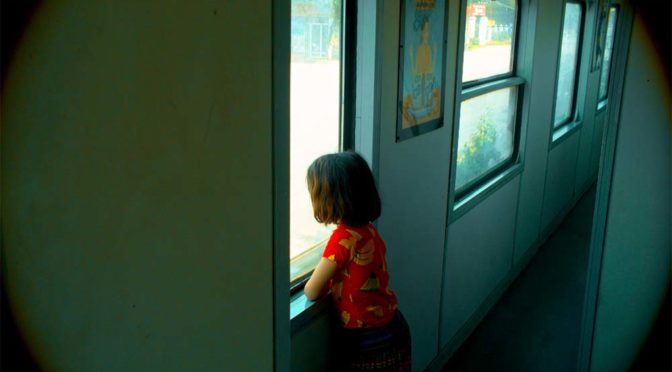Article by Niccolò Buttigliero
Translated by Mattia Prelle
A 64 minutes and 1.700 kilometers long train trip that swings between light and darkness, plumbing a metaphysical Vietnam. It moves through the 17th parallel – the most bombed place in the world – and the Ruc settlement, a population who fans the holy fire whose extinction would cause the extinction of the world too.
Tin Dirdamal travels driven by the desire of being reunited with a childhood friend who is lost into the realm of madness and who is mysteriously charged with murder. He is accompanied by his daughter Eva (Cadena), co-author of the film. We can’t see the starting point nor the arrival point, we can just fleetingly live into the journey dimension. Tin inspects only the wagons, the passengers’ faces; Eva, complementary to him, directs her look solely outside the window, gazing at the landscape. Father/daughter. Inside/outside. Meanwhile, they submit the space they are leaving behind to a process of concrete abstraction similar to the one triggered by Apichatpong Weerasethakul in Sud sanaeha (2002). The space becomes spiritual, unreal. The constant clatter of the rail gradually fades into an ambient composition, soothing us – along with Eva’s constant voice over – and slipping into the absolute inwardness. Dirdamal doesn’t aim to solve the riddle, on the contrary, he inhabits its depths like an addict. Eva’s words de-narrate themselves, becoming flashes of poetry, and sometimes, total black.
“This film was made by a director who is going to quit being a director and will start being simply a man. One day, this man will die, like the film, exactly 730 days after its first projection.”
Luz Viaje Oscuro – second chapter of the tetralogy titled “Light and the Beginning of Future” – is an anti-film, in the same way Tin Dirdamal is anti-cinema. His films are destined to the oblivion: Tin doesn’t yearn for eternal graphic forms, on the contrary, he searches for the transience of the images. The evanescence, instead of the infinite technical reproducibility. Pursuing this kind of vision, Diradmal has established the Hanoi Dogma, a “vow of chastity” comparable to the one of Vinterberg and Von Trier. A negative manifesto, by which Diradmal states his intention of “killing” his own films two years after their premiere. He shows at the same time a total opening to any kind of plagiarism and appropriation of others. Critically opposing a logic of power in which the eternal domination of the appearance survives the fiery flow of time. If a work resists, it occurs in the metamorphosis of an endless anti-authorial reworking. And what remains feeds the night.

